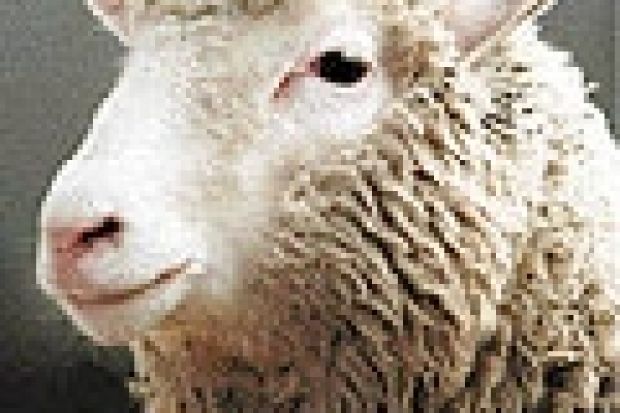When Dolly the sheep was born, journalists from around the world focused their attention on her and two human researchers from the Roslin Institute near Edinburgh in Scotland. Dolly was the first mammal to be cloned from an adult cell. She was a haunting spectacle. Dolly was less an individual than a replica and, being such, she brought forth the undeniable possibility that one day anyone might stare at themselves or a long-lost family member, not in a mirror or a photograph, but directly.
The irony of this image of Dolly is that cloning is not new. Dolly was not the first animal to be cloned by humans, not even the first sheep to be cloned in the Roslin labs. Plants and animals have used cloning technology for at least a billion years. Whenever you take and successfully propagate a cutting from a plant, you are cloning it. Dandelions reproduce by cloning, and without any help from humans. There may be as few as eight different dandelion "individuals" in all of North America, all those millions upon millions of delightful yellow flowers being mere clones of one another. Nine-banded armadillo embryos clone themselves making eight identical offspring. Humans do the same, but less frequently and with less fecundity: identical twins are clones that arise from a zygote that has divided into two.
So why the uproar about something that any bacterium can do? As Roslin scientists Ian Wilmut and Keith Campbell say in The Second Creation , their work is less about cloning than about "finding out how cells work". Bacteria, dandelions and even some lizards can clone themselves because their cells are what cell biologists call "totipotent". Totipotent cells can act as gametes, the founders of a new generation. Dolly was cloned from an adult cell even though adult cells in mammals have lost their totipotency. Adult cells are "differentiated" or committed to being blood cells, liver cells, nerve cells, skin cells, or one of the many other cell types in the body. Before Wilmut and Campbell's research, it was a century-old dogma of cell biology that once a mammalian cell had differentiated, there was no going back. All previous animal clones had been derived from embryonic cells.
Wilmut and Campbell, by thinking hard about how cells work, developed ways to "reprogram" or un differentiate cells. Dolly was thus more an intellectual triumph of cell biology than the first clone. Two sheep who preceded her at Roslin, Megan and Morag, were also clones, just not clones from an adult cell. In another ironic twist, their notoriety - and the popular impact of the science that produced them - was stunted when only a few days after their birth a gunman shot and killed schoolchildren in the small Scottish town of Dunblane. All this serves to emphasise the real theme of Wilmut and Campbell's book (written with science writer Colin Tudge): that the fact of cloning is far less important than the uses to which the knowledge required to produce it can be put. Following Dolly, Roslin scientists showed off Polly. Born a year after Dolly, Polly is cloned and genetically engineered to produce a scarce human blood-clotting factor in her milk.
Wilmut and Campbell devote their penultimate chapter to stories such as Polly's and to some of the many other uses for cloning. This is the "second creation" of their title, as scientists acquire the means to use animals to produce products of therapeutic, economic and even aesthetic benefit. In addition to producing medical treatments, cloned and genetically engineered animals may prove useful in organ transplantation. Ultra-productive farm animals might be replicated, and rare or scarce animals saved from extinction by cloning.
Even if some of the uses to which cloning might be put seem unpleasant or unethical, applications such as animal conservation challenge the Luddites by showing that there may be something in cloning for nearly everyone.
The shadow of human cloning tugs like a heavy ball and chain on every page of this book. Human cloning is undoubtedly possible and someday, someone will almost certainly undertake it. The Boys from Brazil is no longer a fantasy. Wilmut and Campbell repeatedly emphasise their repugnance at the idea, and maintain that the science and the technology that can flow from it must be judged separately. This book gives proponents and critics of that view much to think over.
The Second Creation is modestly presented and authoritative. It gives clear and untechnical descriptions of how cells work, the intricacies of cell cycles and the techniques of cloning. The authors' hope is to educate readers about a coming biotechnology that they think will define important dimensions of this new century. For once, the hyperbole surrounding a new technology may be correct. In a generation or two, cloning and genetic-engineering technologies are likely to be as widespread and as taken for granted as televisions are today.
Mark Pagel is professor of evolutionary biology, University of Reading.
Register to continue
Why register?
- Registration is free and only takes a moment
- Once registered, you can read 3 articles a month
- Sign up for our newsletter
Subscribe
Or subscribe for unlimited access to:
- Unlimited access to news, views, insights & reviews
- Digital editions
- Digital access to THE’s university and college rankings analysis
Already registered or a current subscriber? Login
